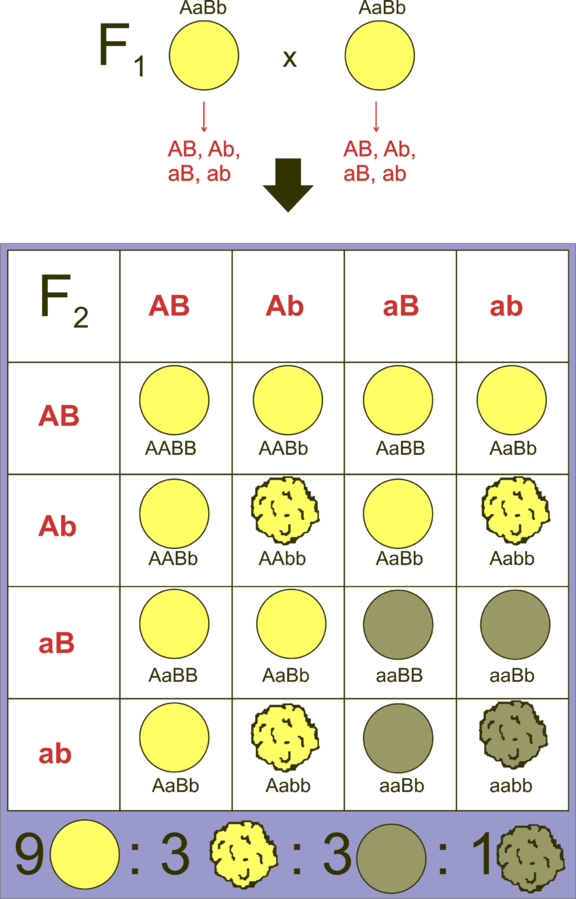
How many plants are dihybrid in
a. One
b. Two
c. Four
d. Sixteen
Answer
484.8k+ views
Hint: Mendel conducted his experiments using several true-breeding lines of Pisum sativum where a true breeding line is that having undergone continuous self-pollination, shows the stable trait inheritance and expression for several generations.
Complete answer:
Mendel selected a total of 14 true-breeding pea plant varieties, such as the height of the stem whether tall or dwarf as pairs which were similar except for one character with contrasting traits. It means, Mendel selected 7 characters that are seed shape, seed colour, pod colour in pea plant for carrying out hybridization experiments and to study inheritance. He crossed pea plants that differed in two characters and called this a dihybrid cross. A cross was made that is they are allowed for pollination between a pure round yellow-seeded pea plant (RRYY) with wrinkled green-seeded pea plant (rryy).
Yellow colour is dominant that it can be shown with or without green seeds over green and round seed shape over wrinkled seed shape.
Such phenotypic ratio

So the ratio of the dihybrid cross was found to be
Hence, the correct answer is option (C).
Note: Based upon the results obtained in dihybrid crosses, Mendel proposed a second set of generalisations that we call Mendel's Law of Independent Assortment. This law states that "when two pairs of traits say for instance seeds shape and pod colour are combined in a hybrid, the separation of 1 pair of traits is independent of the one pair of traits".
Complete answer:
Mendel selected a total of 14 true-breeding pea plant varieties, such as the height of the stem whether tall or dwarf as pairs which were similar except for one character with contrasting traits. It means, Mendel selected 7 characters that are seed shape, seed colour, pod colour in pea plant for carrying out hybridization experiments and to study inheritance. He crossed pea plants that differed in two characters and called this a dihybrid cross. A cross was made that is they are allowed for pollination between a pure round yellow-seeded pea plant (RRYY) with wrinkled green-seeded pea plant (rryy).
Yellow colour is dominant that it can be shown with or without green seeds over green and round seed shape over wrinkled seed shape.
Such phenotypic ratio

So the ratio of the dihybrid cross was found to be
Hence, the correct answer is option (C).
Note: Based upon the results obtained in dihybrid crosses, Mendel proposed a second set of generalisations that we call Mendel's Law of Independent Assortment. This law states that "when two pairs of traits say for instance seeds shape and pod colour are combined in a hybrid, the separation of 1 pair of traits is independent of the one pair of traits".
Latest Vedantu courses for you
Grade 11 Science PCM | CBSE | SCHOOL | English
CBSE (2025-26)
School Full course for CBSE students
₹41,848 per year
Recently Updated Pages
Master Class 4 Maths: Engaging Questions & Answers for Success

Master Class 4 English: Engaging Questions & Answers for Success

Master Class 4 Science: Engaging Questions & Answers for Success

Class 4 Question and Answer - Your Ultimate Solutions Guide

Master Class 11 Economics: Engaging Questions & Answers for Success

Master Class 11 Business Studies: Engaging Questions & Answers for Success

Trending doubts
Give 10 examples of unisexual and bisexual flowers

Draw a labelled sketch of the human eye class 12 physics CBSE

a Tabulate the differences in the characteristics of class 12 chemistry CBSE

Differentiate between homogeneous and heterogeneous class 12 chemistry CBSE

Why is the cell called the structural and functional class 12 biology CBSE

Differentiate between insitu conservation and exsitu class 12 biology CBSE




